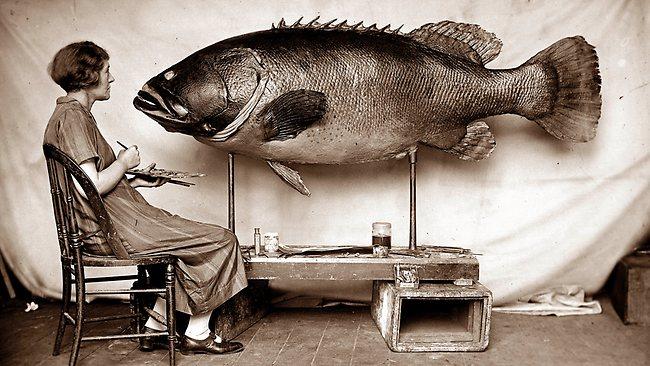A tasty offering of fish and ships
STEPHEN Scheding's exhibition is displayed across two levels at the National Maritime Museum in Sydney.

STEPHEN Scheding's exhibition devoted to the theme of fish and fishing in Australian art, Fish in Australian Art, is displayed across two levels at the National Maritime Museum in Sydney.
The first level is full of intriguing things such as a model of a boat designed to move by emulating the twisting or slithering motion of fish and snakes.
One wonders whether this idea was serious or tongue-in-cheek, but it is in fact the work of one of Australia's great aeronautical pioneers, Lawrence Hargrave.
Also in this section is a pair of amateur watercolours from the mid-19th century: in one a tiny fisherman sits on a log overlooking the river, while in the second he has been pulled underwater by the monstrous fish he has hooked. Though naive in style, these little pictures speak of a universal and atavistic terror of the unknown lurking under the surface of water, which survives in the vestigial touch of excitement we experience whenever we dive into a pool.
Nearby, and evoking similar anxieties, is a bronze of a sea nymph or mermaid being devoured by a gigantic fish, the work of Barbara Tribe called Spirit of the Sea (1933).
This first section, however, is but the hors d'oeuvre to the main exhibition downstairs, which is at once serious in its depth and eclectic in its range across media and historical periods.
We are greeted by Cat and Fish, a slightly disconcerting painting of a cat guarding a catch of fish, a picture painted by William Buelow Gould, the convict artist in Tasmania, most probably to support his drinking habit.
Beyond this is a selection of the very earliest drawings made in the new colony, by an anonymous, presumably young, naval officer still known only as the Port Jackson Painter.
His works are held in the Natural History Museum in London; those chosen for the show illustrate the fishing techniques of the native inhabitants of Sydney, and reflect an open-minded Enlightenment curiosity about other peoples and their ways of life.
Many later paintings and photographs take fishing as their subject, a collective activity when commercially practised, yet often solitary and contemplative, even melancholy, as a hobby -- as we see especially in an evocative watercolour, The Beach Fisherman (1934), by Kenneth Macqueen.
There are also images of people with the fish they have caught: almost a sub-genre, whose fundamental purpose is to prove the size of the creature they have taken.
These pictures can be quite strange, the oddly humourless features of the fisher juxtaposed with the dead fish, but the strangest of such pairings is in the photograph of Miss E. A. King colouring a specimen of a giant Queensland groper for the Australian Museum. There is something quaintly absurd about the spinsterly painter's confrontation with an enormous fish that actually looks like an oversized version of a small one.
Living fish are seen in goldfish bowls too, another curious subject, whose interpretations vary from an Edwardian nude idly reaching down to the goldfish in a round bowl -- symbols no doubt of idle and repressed desire -- to the acid humour of John Brack's square tank with its brilliant decorative fishes. Seafood is evoked by several artists, including Still Life with Pink Fish by Margaret Olley, in a picture from her first solo exhibition; John Olsen, in whose world fish seem to swim of their own accord into the exuberance of a bouillabaisse; and Matilda Michell, with Fish, the darker, more intense and Velazquez-inspired series that won the Waterhouse Natural History Art Prize in 2009.
Natural history illustrations are prominent too, from the earliest days of settlement to the present. Among the most outstanding are watercolours by Sarah Stone and an extraordinary view of the blue swimmer crab from underneath by Ferdinand Bauer (1801-03).
There is a wonderful story about how another naturalist, William von Blandowski, conducted a survey of the fish of the Murray River in 1856-57 and named them after learned colleagues from the Philosophical Institute of Victoria; his apparent tactlessness in describing one of the fishes as slimy and slippery and another as having a low forehead and big belly, however, caused an uproar and there was even an attempt to expel him from the institute.
Scheding is an inveterate collector and researcher, and the result is a fascinating exhibition full of surprises.
The labels are for once well worth reading and contain many unexpected nuggets of art-historical research. Thus we learn that Ian Armstrong's Girl with a Fish (1949-50) was first shown in a group exhibition with two friends, one of whom was Fred Williams.
Armstrong's work was praised by Arnold Shore and the picture was bought by the NGV, while none of Williams's work was sold.
Armstrong's painting is not bad, but it was in a fashionable contemporary idiom, while Williams was on a different and unpredictable trajectory.
Until October 1.
VISUAL ART
Fish in Australian Art
National Maritime Museum, Sydney.




To join the conversation, please log in. Don't have an account? Register
Join the conversation, you are commenting as Logout